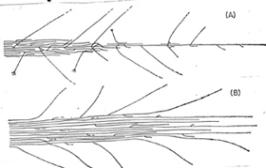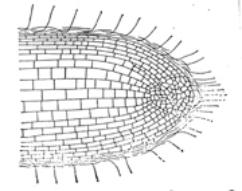|
(click
on the main point headings to jump to the selected
location in the notes)
Fungal
Hyphal Aggregate
Terminology for Basic Tissue-like
Organization of Fungi
Plectenchyma -
hyphal aggregations that appear
tissue-like, but are not because formed from
hyphae not cells (2 types)
Prosenchyma - Plectenchyma having hyphae that remain apparent at
structure's maturity
Pseudoparenchyma -
Plectenchyma having hyphal origin
obscurred at maturity of structure.
Hyphal coordination yielding
multi hyphal aggregates is manifested by:
a)
interhyphal contact causing formation
of plectenchyma
b)
coordinated differentiation with
neighboring hyphae
c)
ultimate formation of morphologically
distinctive, nearly macroscopic to truly
macroscopic structures.
313
(Back
to main points)
Vegetative
Hyphal Aggregates
I.
Strands -
linear hyphal aggregates with the
capacity to extend unidirectionally
A.
Mycelial Strands -
retain hyphal organization at
maturity
B.
Rhizomorphs -
aggregate formed by coordinated
apical extension of a # of aggregated hyphal
tips
vs reproductive
318
(Back
to main points)
Characteristics
of Strands
a)
Thickness is variable (e.g. a few
hyphae to several mm)
b)
Can arise either from a colony or a
sclerotium
c)
Potentially capable of unlimited linear
extension
d)
Give rise to new colonies or to a
reproductive structure
f)
Most often associated with the
production of reproductive bodies (e.g.
basidiocarps)
319
(Back
to main points)
II. Sclerotia*
Firm hyphal aggregates of vegetative
hyphal origin, which exhibit determinent
growth.
"hard time structures"
1.
* Characteristics = have many sizes
and shapes
2.
Often rounded or lobed
3.
Can be as lg as 10 cm in diameter
4.
Usually darkly pigmented
5.
Often exhibit pseudoparochmastous
construction and much anastomosis
6.
"Cells" contain large
concentrations of stored endogenous
substrates
322
(Back
to main points)
Asexual
Reproductive Hyphal Aggregates*
|
|
sing
|
pl
|
|
I
|
Synnema
|
Synnemata
|
|
II
|
Pycnidium
|
Pycnidia
|
|
III
|
Acervulus
|
Acervuli
|
|
IV
|
Sporodochium
|
Sporodochia
|
*aggregates that are
associated with conidium production
325
(Back
to main points)
How formed:
I
Mycelial strands


Main hypha is "adopted" by
so-called "following hyphae" that
have branches that can grow backwards or
forward.
II.
Rhizomorphs

Coordinated apical extension of a #
of hyphal tips
320/165b
'(Back
to main points)
1.
Synnema - simple structures that
result when conidiophores aggregate
a.
Often appear more complex than they
really are
b.
Often macroscopic and mistaken for
slime mold fruit bodies
c.
Often conidiophores exhibit extensive
anastomosis
d.
Such fungi usually members of Fungi
Imperfecti* or anamorphs of Ascomycota
?*
Hyphomycetes - form class
*
Coelomycetes - form class
326
(Back
to main points)
Conidioma
of Coelomycetes
2.
Pycnidium - a flask-shaped, globose
or
oval-shaped structure that looks like
a cleistothecium or a perithecium but has a
cavity filled with conidiophores and conidia
instead of asci- and ascospores.
Often identified incorrectly as an
ascocarp.
3.
Acervulus* - functionally a structure
similar to a pycnidium, but structurally
different by being formed by
plant pathogenic fungi in association
with plant tissue.
*
Oten appears to be a pustule formed
just under plant epidermis, which erupts and
exudes conidia
329
(Back
to main points)
Conidioma (continued)
4.
Sporodochium -
large mass of short conidiophores and
hyphae which arise together from the surface
of a structure
(multihyphal aggregate) called a
stromata (stroma).*
*
Structures like those in which
locuoles are sometimes formed by
Loculomycetes.
*
Stromata can give rise to:
1.
conidia
2.
locuoles & asci
3.
sclerotia
332
(Back
to main points)
Sexual
Reproductive Hyphal Aggregates*
*Carpophores** of
Euascomycotina
|
|
name
|
class
association
|
|
1.
|
cleistothecia
|
Plectomycetes
|
|
2.
|
perithecia
|
Pyrenomycetes,
Laboulbeniomycetes
|
|
3.
|
apothecia
|
Discomycetes
|
|
4.
|
ascostroma
|
Loculomycetes
|
**
Ascocarp-type carpophores***
*Ascomas
*** a)
formed from pseudoparenchymatous
tissue derived from the ascogonium
b)
from primary protective tissue
derived totally from parent hyphae
c)
secondary protective tissue formed
only after stimulation of ascogonium
335
(Back
to main points)
Sexual Hyphal Reproductive
Aggregates* (continued)
Basidiocarps
formed by:
1.
Localized & coordinated branching
and swelling of aggregated hyphae (usually
dikaryotic)
2.
Secondarily by hyphal compaction,
wall thickening, gelatinization and
coloration
3.
Basidiocarp development seems to be
triggered by environmental conditions, since
dikaryotic colonies may grow indefinitely
without producing a basidiocarp
345
(Back
to main points)
Basidiocarp Developmental
Patterns among
some
Hymenomycetes (Homobasidiomycotina)
1.
Gymnocarpus*
primordium develops into a gilled
mushroom-like structure in such a way that
basidia are always exposed during
formation**
*
as in Aphyllophorales
**
as per S.
commune
346
(Back
to main points)
Basidiomycete developmental
patterns leading to mushrooms (continued)
Agaricales
Hemiangiocarpic
gills and basidia of mushroom develop
in "hidden" fashion, although
mushroom development is apparent
Angiocarpic
mushroom development is not obvious
until mushroom is relatively mature; gills
again hidden.
347
(Back
to main points)
Review
of Holobasidiomycotina
Classes
and Orders
Subphylum
- Holobasidiomycotina
Class
- Phragmobasidiomycetes* (5 orders)
Order
- Tremellales
(have cruciately septate Basidia)
Order
- Auriculariales
(have transversely septate Basidia)
*
have septate basidia
Class
– Holobasidiomycetes (27 orders)**
Order
- Dacrymycetales
(have tuning-fork type basidium)
Order
- Tulasnellales (have holobasidia with
swollen sterigmata)
**
All but these two have typical holobasidia
Basidiomycota Classification (cont.)
Subphylum
- Holobasidiomycotina * (cont.)
Class
– Holobasidiomycetes (selected orders
cont.)
Order
- Agaricales (the mushrooms)
Order
– Boletales (the fleshy pore fungi)
Order
– Cantharelles (chantarelles, and tooth
fungi, etc.)
Order
- Exobasidials
Order
- Gautieriales
Order
- Hymenogastrales
Order
- Lycoperdales (the puffballs, earth stars,
etc.)
Order
- Melanogastrales
Order
- Nidulariales (the bird's nest fungi)
Order
- Phallales (the stinkhorns)
Order
- Porales (woody shelf fungi or woody
bracket fungi)
Order
– Thelephorales (the coral and leather
fungi)
Order
– Sclerodermatales (the earth balls)
*
most have typical holobasidum, but different
kinds of basidiocarps
355
(Back
to main points)
|

